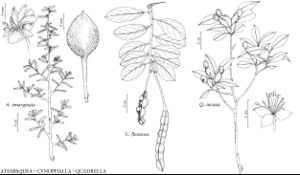Capparaceae
Shrubs or trees (deciduous or evergreen); spines absent (usually without thorns except Atamisquea); glabrous or puberulent with stellate trichomes or lepidote scales (producing glucosinolates). Stems erect or spreading; sparsely to profusely branched. Leaves alternate and distichous or spirally arranged, simple [palmately compound]; venation pinnate; stipules caducous, scalelike or absent; petioles present (pulvinus absent, nectaries present or absent, [petiolar spines present]); blade margins entire. Inflorescences terminal or axillary, usually racemose, sometimes corymbose or flowers solitary; pedunculate; bud-scales usually persistent; bracts absent. Pedicels present. Flowers bisexual (sometimes appearing unisexual), actinomorphic or slightly zygomorphic, rotate to crateriform, campanulate, or urceolate; perianth and androecium hypogynous; sepals usually persistent (deciduous in Quadrella incana), 4, distinct; petals 4, attached directly to receptacle, imbricate, distinct, equal; intrastaminal nectary-discs or glands present or absent; stamens 6–250; filaments distinct, glabrous or pubescent; anthers dehiscing by longitudinal slits, pollen shed in single grains, binucleate, commonly tricolporate; pistil 1; ovary 1-carpellate, 2-locular; placentation parietal; ovules anatropous, bitegmic; style 1, (straight, relatively short and thick); stigma 1, capitate, unlobed. Fruits capsules or berries, valvate, elongate, dehiscent or not by 2 lateral valves (stipitate from elongation of gynophore). Seeds 1–38 or many, usually tan to yellowish-brown or brown, sometimes green; arillate or not; endosperm scanty or absent, sometimes a persistent perisperm present; cotyledons incumbent to accumbent, (radicle-hypocotyl relatively short and conical). x = 8, 10.
Distribution
Worldwide, tropical and warm-temperate regions
Discussion
Genera ca. 28, species ca. 650 (3 genera, 4 species in the flora).
The broad circumscription of Capparaceae followed by A. Cronquist (1981) was similar to that of F. Pax and K. Hoffmann (1936). Traditionally, the approximately 45 genera and 800 species of Capparaceae in a broader sense have been classified into two major subfamilies, Capparoideae and Cleomoideae. Molecular and morphological analyses of the family and its relatives reveal that Capparaceae as traditionally circumscribed is paraphyletic, with the larger, mostly temperate family Brassicaceae embedded within it (J. E. Rodman et al. 1993, 1996; W. S. Judd et al. 1994; J. C. Hall et al. 2002, 2004). Chloroplast sequences strongly support the monophyly of each of the three lineages Brassicaceae, Capparaceae, and Cleomaceae, with strong support for a sister relationship of Cleomaceae to Brassicaceae (Hall et al. 2002, 2004). Rather than merging the three families into one, all-inclusive Brassicaceae (in the sense of Angiosperm Phylogeny Group 1998, 2003), it might be more acceptable to recognize the three clades as separate, amply distinct families (Zang M. L. and G. C. Tucker 2008). This bears out the proposal of the family by H. K. Airy Shaw (1964), who noted that recognition of Cleomaceae was “a logical necessity.” Cleomaceae can be distinguished from Capparaceae as follows:
Selected References
Lower Taxa
Illustrations
| Family ⠉ | Taxon | Illustrator ⠉ | |
|---|---|---|---|
 | Capparaceae Capparaceae Capparaceae | Atamisquea emarginata Cynophalla flexuosa Quadrella incana | Yevonn Wilson-Ramsey Yevonn Wilson-Ramsey Yevonn Wilson-Ramsey |
Key
| 1 | Plants usually glabrous or glabrescent, or rarely puberulent (hairs minute, stellate or simple) on branches, inflorescences, or abaxial surface of leaves. | Cynophalla |
| 1 | Plants lepidote or hairy (hairs stellate) on leaves, branchlets, and abaxial surface of sepals | > 2 |
| 2 | Leaf blades narrowly oblong to linear-oblong; inflorescences racemes or flowers solitary (in axils ofdistal leaves); stamens ca. 6. | Atamisquea |
| 2 | Leaf blades ovate to ovate-elliptic or narrowly to broadly elliptic or lanceolate; inflorescences racemes or corymbs; stamens 8-30. | Quadrella |